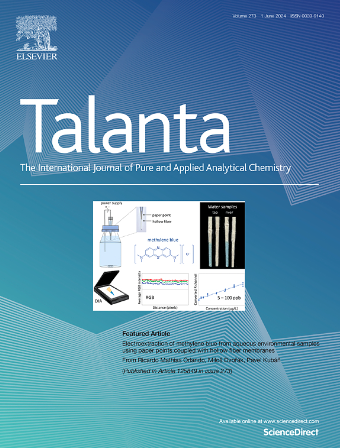Favipiravir是否与DNA相互作用?设计电化学DNA纳米生物传感器,研究DNA与Favipiravir治疗COVID-19的相互作用
IF 6.1
1区 化学
Q1 CHEMISTRY, ANALYTICAL
引用次数: 0
摘要
SARS-CoV-2 (COVID-19)疫情对快速诊断测试和治疗药物都提出了全球性挑战。在此背景下,首次采用裸多壁碳纳米管(MWCNTs)修饰一次性铅笔石墨电极(PGE)设计了电化学DNA生物传感器,用于研究大流行期间感染SARS-CoV-2的患者使用的药物之一Favipiravir (FAV)与DNA的相互作用。这种药物及其衍生物在大流行期间被广泛使用,Favipiravir对DNA可能产生的影响尚未通过电化学(纳米)生物传感器技术进行详细研究。本研究采用FAV标准剂型和片剂剂型,分别采用差分脉冲伏安法(DPV)和循环伏安法(CV)进行检测,比较其对DNA的影响。此外,利用扫描电镜(SEM)对制备的MWCNTs修饰的电化学DNA生物传感器进行了表征。观察到FAV与DNA相互作用,导致鸟嘌呤氧化信号在+1.00 V左右显著降低。所设计的基于mwcnt的纳米生物传感器能够在低至0.66 μg/mL (LOD)的FAV浓度范围为150 ~ 500 μg/mL的线性范围内检测DNA-Favipiravir药物相互作用。由于相互作用时间短(近32分钟),进行了快速分析。本文章由计算机程序翻译,如有差异,请以英文原文为准。

Does Favipiravir interact with DNA? Design of electrochemical DNA nanobiosensor to investigate the interaction between DNA and Favipiravir used in the treatment of COVID-19
The SARS-CoV-2 (COVID-19) outbreak has presented a global challenge for both rapid diagnostic tests and therapeutic drugs. In this context, the electrochemical DNA-based biosensor was designed for the investigation of DNA and Favipiravir (FAV) which was one of the drugs used in patients infected SARS-CoV-2 during the pandemic interaction by using bare and multi-walled carbon nanotube (MWCNTs) modified disposable pencil graphite electrode (PGE) for the first time. This drug and its derivatives were used extensively during the pandemic period, and the possible effects of Favipiravir on DNA have not yet been investigated in detail with electrochemical (nano) biosensor technologies. In this study, both the standard form of FAV and the tablet form were used and tested with differential pulse voltammetry (DPV) and cyclic voltammetry (CV) to compare their effects on DNA. Besides, scanning electron microscopy (SEM) was used for the characterization of the developed MWCNTs modified electrochemical DNA biosensor. It was observed that FAV interacts with DNA and causes a significant decrease in the guanine oxidation signal at about +1.00 V. The designed MWCNT-based nanobiosensor was able to detect DNA-Favipiravir drug interaction in FAV concentration as low as 0.66 μg/mL (LOD) with a linear range from 150 to 500 μg/mL. Rapid analysis due to short interaction time (nearly 32 min) was performed.
求助全文
通过发布文献求助,成功后即可免费获取论文全文。
去求助
来源期刊

Talanta
化学-分析化学
CiteScore
12.30
自引率
4.90%
发文量
861
审稿时长
29 days
期刊介绍:
Talanta provides a forum for the publication of original research papers, short communications, and critical reviews in all branches of pure and applied analytical chemistry. Papers are evaluated based on established guidelines, including the fundamental nature of the study, scientific novelty, substantial improvement or advantage over existing technology or methods, and demonstrated analytical applicability. Original research papers on fundamental studies, and on novel sensor and instrumentation developments, are encouraged. Novel or improved applications in areas such as clinical and biological chemistry, environmental analysis, geochemistry, materials science and engineering, and analytical platforms for omics development are welcome.
Analytical performance of methods should be determined, including interference and matrix effects, and methods should be validated by comparison with a standard method, or analysis of a certified reference material. Simple spiking recoveries may not be sufficient. The developed method should especially comprise information on selectivity, sensitivity, detection limits, accuracy, and reliability. However, applying official validation or robustness studies to a routine method or technique does not necessarily constitute novelty. Proper statistical treatment of the data should be provided. Relevant literature should be cited, including related publications by the authors, and authors should discuss how their proposed methodology compares with previously reported methods.
 求助内容:
求助内容: 应助结果提醒方式:
应助结果提醒方式:


